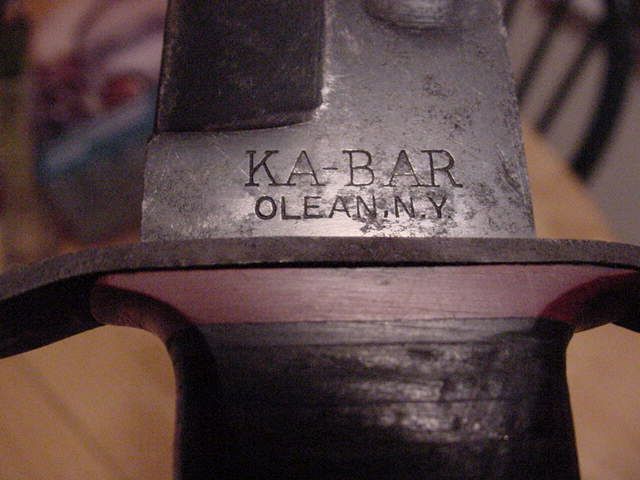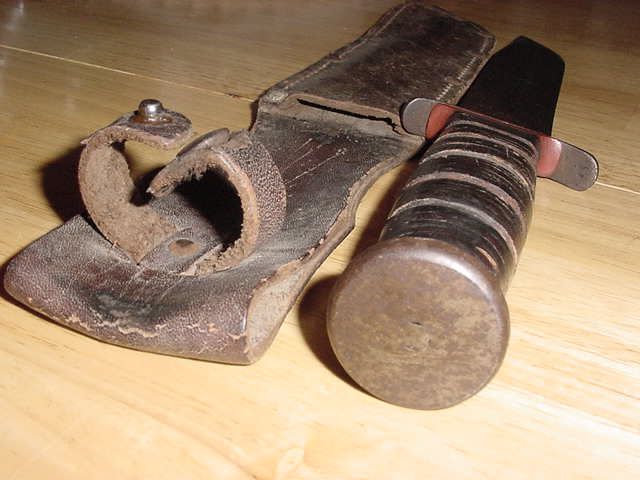1219C2 Combat Knife / USMC Mark 2 Combat Knife KA-BAR
Mar 17, 2014 7:35:42 GMT
Post by Jack Loomes on Mar 17, 2014 7:35:42 GMT





Early production model (Union Cutlery)
Used by:
United States Marine Corps
United States Navy
Wars:
World War II
Korean War
Vietnam War
Invasion of Grenada
Operation Just Cause
Gulf War
War in Afghanistan
Iraq War
Designed:
23 November 1942
Manufacturers:
Camillus Cutlery Co.
Union Cutlery Co.
Pal Cutlery Co.
Robeson (ShurEdge) Cutlery Co.
Produced: 1943–present
Specifications
Weight 1.23 pounds (0.56 kg)
Length 11.875 inches (30.16 cm)
Blade length: 7 inches (18 cm)
Blade type: Bowie
Hilt type: Stacked leather washers
Scabbard/sheath Leather (USMC) or Plastic (USN)
In response to a specification requesting for a modern individual fighting knife design for the U.S. Marines, ordnance and quartermaster officials requested submissions from several military knife and tool suppliers to develop a suitable fighting and utility knife for individual Marines, using the U.S. Navy Mark 1 utility knife and existing civilian hunting/utility knives such as Western's L77 as a basis for further improvements. Working with Union Cutlery, USMC Colonel John M. Davis and Major Howard E. America contributed several important changes, including a longer, stronger blade, the introduction of a small fuller to lighten the blade, a peened pommel (later replaced by a pinned pommel), a straight (later, slightly curved) steel crossguard, and a stacked leather handle for better grip. The blade, guard, and pommel were coated with a non-reflective matte phosphate finish instead of the brightly polished steel of the original prototype. The design was given the designation of 1219C2. Notably, the 1219C2 used a thicker blade stock than that of the USN Mark 1 utility knife, and featured a stout clip point. After extensive trials, the 1219C2 prototype was recommended for adoption. The Marines' Quartermaster at the time initially refused to order the knives, but his decision was overruled by the Commandant. The Marine Corps adopted the new knife on November 23, 1942, still under the designation 1219C2.
The 1219C2 proved easy to manufacture; the first production run was shipped by Camillus Cutlery Co. on January 27, 1943. After the U.S. Navy became disenchanted with blade failures on the USN Mark 1 utility knife, the latter service adopted the 1219C2 as the US Navy Utility Knife, Mark 2. The Marine Corps in turn re-designated the 1219C2 as either the USMC Mark 2 Combat Knife, or simply the Knife, Fighting Utility. In naval service, the knife was used as a diving and utility knife from late 1943 onward, though the stacked leather handle tended to rot and disintegrate rapidly in saltwater.
The Marine Corps issued USMC Mark 2 combat/fighting utility knife throughout Marine forces, with early deliveries going primarily to elite formations. In late 1943 the 1219C2 replaced the Marine Raider Stiletto in service, a change welcomed by the marines of Col. Edson's 1st Raider Battalion, who found the Raider stiletto ideal for silent killing but of little use for anything else. As the knife went into large-scale production, the Marines issued the Mark 2 Combat/Fighting Utility knife to reconnaissance and engineering units and to any Marine armed with the pistol, M1 carbine, BAR, or crew-served machine gun (rifle-armed Marines were typically issued a bayonet). Marines were often issued knives with "U.S.N. Mark 2" markings when Navy-issued Mark 2 knives were all that was available. By 1944 the USMC Mark 2 Combat/Fighting Utility knife was issued to virtually any Marine in the combat branches who desired one, and was in use by Marine Corps close combat instructors for training new recruits. Unlike the prior Marine Raider stiletto, Marines were taught to use their new knife primarily as a slashing weapon in the initial phases of hand-to-hand combat.
As its new name implied, the "Knife, Fighting Utility" was designed from the outset as a dual-purpose knife: it was both an effective combat knife and a utility tool, well-suited to the type of jungle warfare encountered by Marines in the Pacific theater. This dual-purpose design resulted in some initial criticism of the pattern as being less than ideal for knife fighting, but combat experience of returning veterans as well as field reports from the battlefield soon dispelled any doubts about its combat effectiveness.
After the Second World War, the U.S. Navy and Marine Corps continued to use the Mark 2 Combat/Fighting Utility knife. In addition to military contract knives, the knife was produced for the civilian market, and the pattern enjoyed some popularity as a general-purpose hunting and utility knife.
Manufacturers and the "KA-BAR" name.
Camillus Cutlery Co., the first manufacturer to supply the 1219C2 combat knife under contract, also produced the largest number of such knives, producing over 1 million examples marked "Camillus.N.Y." on the blade's ricasso before the war ended. Besides Camillus, the Union Cutlery Co., Robeson (ShurEdge) Cutlery Co., and the PAL Cutlery Co. all produced the Mark 2 combat/fighting utility knife under military contract during World War II. The Union Cutlery Company, the first company to manufacture a knife trademarked KA-BAR, was founded in 1897 as the Tidioute Cutlery Co. The Tidioute Cutlery Co. was dissolved and its assets taken over by Wallace R. Brown, who renamed the company Union Razor Co. which shortly thereafter became the Union Cutlery Company in 1909, headquartered in Olean, New York.
Of the four wartime manufacturers, Union Cutlery Co. was the sole wartime knife manufacturer to stamp all Mark 2 Combat/Fighting Utility knives they made for the military with their "KA-BAR" trademark on the blade's ricasso, and was second only to Camillus in terms of production, producing about 1 million knives during the wartime contract. Because of this prominent trademark, Marines as early as 1944 began universally referring to their new combat knife as the "KA-BAR", regardless of manufacturer. The popular designation of the knife as the "KA-BAR" may also have resulted from contact with Marine Corps close combat instructors in San Diego, who appear to have used the term "KA-BAR" when training recruits in the skill of knife fighting.
After the end of World War II, Utica Cutlery Co., Conetta Cutlery Co., Camillus Cutlery Co., and (beginning around 1980) the Ontario Knife Co. all produced the Mark 2 under contract for the U.S. military. From approximately 1945-1952, Weske Cutlery Co. of Sandusky, Ohio purchased leftover and overrun parts from wartime Mark 2 knife contractors and assembled them into knives for commercial sale, polishing out the original manufacturer and military markings, and fitting them with ungrooved leather handles. Though W.R. Case made two prototype 1219C2 knives as part of a contract submission in 1942-43, no contract was ever awarded to Case for the production of military Mark 2 Combat/Fighting Utility knives, either during or after World War II. In 1992, Case would release a modern commemorative of these prototypes, the Case XX USMC Fighting Utility Knife. The Case XX USMC Fighting Utility knife is actually manufactured for Case by Ontario Knife Co.
From 1923 until 1952, KA-BAR remained a legal trademark of Union Cutlery Company. However, in 1952 Union Cutlery renamed itself KA-BAR Cutlery Inc. in order to capitalize on widespread public recognition of the "KA-BAR" name and trademark, which had by then become synonymous with the well-regarded but confusingly titled USMC Mark 2 Combat Knife or Knife, Fighting Utility of the late war. While the company name changed, KA-BAR, Inc.'s headquarters are still located in Olean, New York. Cutco Corporation, manufacturer of Cutco Cutlery, acquired the company in 1996.
KA-BAR makes Army and Navy versions as well as USMC versions. They are the same as the Marine version except for different initials at the bottom of the blade and different symbols on the sheath. Marines today often give the blades, guards and pommels of their knives a few coats of non-reflective matte black spray paint to reduce reflected light and give them a little more protection against saltwater corrosion. Its moderate carbon and low chromium steel mixture allows the blade to hold an edge very well. The 1095 chrome-vanadium steel used in the blades of contemporary KA-BARs has a hardness of 56–58 HRC, while the guard and pommel are made from sintered 1095 carbon steel. Besides use as a fighting knife, the Mark 2 has proven its usefulness as a utility knife, used for opening cans, digging trenches, and cutting wood, roots, wire, and cable. In 1995, the design was updated with a tool steel blade, synthetic handle, and synthetic sheath marketed as "The Next Generation". As of June 2012 the "Next Generation" models have been discontinued.
Sources: www.kabar.com/most-famous-knife
en.wikipedia.org/wiki/Ka-Bar

.png?width=1920&height=1080&fit=bounds)